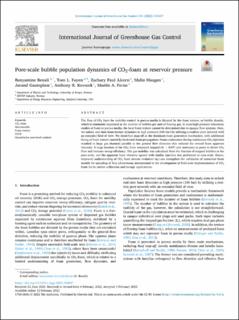| dc.contributor.author | Benali, Benyamine | |
| dc.contributor.author | Føyen, Tore Lyngås | |
| dc.contributor.author | Alcorn, Zachary Paul | |
| dc.contributor.author | Haugen, Malin | |
| dc.contributor.author | Gauteplass, Jarand | |
| dc.contributor.author | Kovscek, Anthony R. | |
| dc.contributor.author | Fernø, Martin | |
| dc.date.accessioned | 2022-08-05T09:18:52Z | |
| dc.date.available | 2022-08-05T09:18:52Z | |
| dc.date.created | 2022-02-18T11:03:45Z | |
| dc.date.issued | 2022 | |
| dc.identifier.citation | International Journal of Greenhouse Gas Control. 2022, 114 1-11. | en_US |
| dc.identifier.issn | 1750-5836 | |
| dc.identifier.uri | https://hdl.handle.net/11250/3010301 | |
| dc.description.abstract | The flow of CO2 foam for mobility control in porous media is dictated by the foam texture, or bubble density, which is commonly expressed as the number of bubbles per unit of flowing gas. In most high-pressure laboratory studies of foam in porous media, the local foam texture cannot be determined due to opaque flow systems. Here, we unlock real-time foam texture dynamics at high pressure (100 bar) by utilizing a realistic pore network with an extended field of view. We identified snap-off as the dominant foam generation mechanism, with additional fining of foam texture caused by backward foam propagation. Foam coalescence during continuous CO2 injection resulted in large gas channels parallel to the general flow direction that reduced the overall foam apparent viscosity. A large fraction of the CO2 foam remained trapped ( > 0.97) and stationary in pores to divert CO2 flow and increase sweep efficiency. The gas mobility was calculated from the fraction of trapped bubbles at the pore-scale, and the apparent foam viscosity agreed with similar injection test performed at core-scale. Hence, improved understanding of CO2 foam texture evolution () can strengthen the validation of numerical foam models for upscaling of flow phenomena, instrumental in the development of field scale implementation of CO2 foam for in carbon utilization and storage applications. | en_US |
| dc.language.iso | eng | en_US |
| dc.publisher | Elsevier | en_US |
| dc.rights | Navngivelse 4.0 Internasjonal | * |
| dc.rights.uri | http://creativecommons.org/licenses/by/4.0/deed.no | * |
| dc.subject | Quantitative pore-level analysis | en_US |
| dc.subject | CCUS | en_US |
| dc.subject | Foam texture | en_US |
| dc.subject | Micromodels | en_US |
| dc.subject | CO2 foam | en_US |
| dc.title | Pore-scale bubble population dynamics of CO2-foam at reservoir pressure | en_US |
| dc.title.alternative | Pore-scale bubble population dynamics of CO2-foam at reservoir pressure | en_US |
| dc.type | Peer reviewed | en_US |
| dc.type | Journal article | en_US |
| dc.description.version | publishedVersion | en_US |
| dc.rights.holder | © 2022 The Author(s). Published by Elsevier Ltd | en_US |
| dc.source.pagenumber | 1-11 | en_US |
| dc.source.volume | 114 | en_US |
| dc.source.journal | International Journal of Greenhouse Gas Control | en_US |
| dc.identifier.doi | 10.1016/j.ijggc.2022.103607 | |
| dc.identifier.cristin | 2003239 | |
| dc.relation.project | Norges forskningsråd: 249742 | en_US |
| dc.relation.project | Norges forskningsråd: 268216 | en_US |
| dc.relation.project | Norges forskningsråd: 294886 | en_US |
| dc.relation.project | Norges forskningsråd: 301201 | en_US |
| dc.source.articlenumber | 103607 | en_US |
| cristin.ispublished | true | |
| cristin.fulltext | original | |
| cristin.qualitycode | 1 | |

